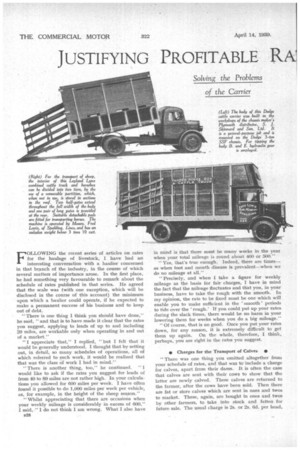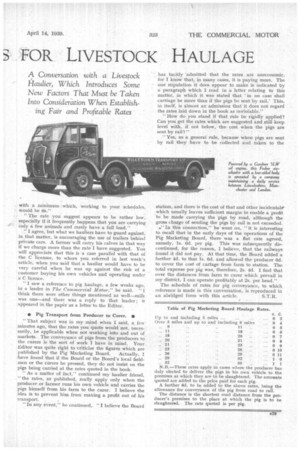JUSTIFYING PROFITABLE RA'
Page 38

Page 39

If you've noticed an error in this article please click here to report it so we can fix it.
FOR LIVESTOCK HAULAGE
A Conversation with a Livestock Haulier, Which Introduces Some New Factors That Must be Taken Into Consideration When Establish
ing Fair and Profitable Rates
FOLLOWING the recent series of articles on rates for the haulage of livestock, I have had an interesting conversation with a hardier concerned in that branch of the industry, in the course of which several matters of importance arose. In the first place, he had something very favourable to remark about the schedule of rates published in that series. He agreed that the scale was (with one exception, which will be disclosed in the course of this account) the minimum upon which a haulier could operate, if he expected to make a permanent success of his business and to keep out of debt.
"There is one thing I think you should have done," he said, "and that is to have made it clear that the rates you suggest, applying to leads of up to and including 20 miles, are workable only when operating in and out of a market."
"I appreciate that," I replied, "but I felt that it would be generally understood. I thought that by setting out, in detail, so many schedules of operations, all of which referred to such work, it would be realized that that was the class of work I had in mind."
" There is another thing, too," he continued. "I would like to ask if the rates you suggest for leads of from 40 to 80 miles are not rather high. In your calculations you allowed for 600 miles per week. I have often found it possible to do 1,000 miles per week per vehicle, as, for example, in the height of the sheep season."
"Whilst appreciating that there are occasions when your weekly mileage is considerably in excess of 600," I said, " I do not think I am wrong. What I also have
a28 in mind is that there must be many weeks in the year when your total mileage is round about 400 or 500."
"Yes, that's tree enough. Indeed, there are times— as when foot and mouth disease is prevalent—when we do no mileage at all."
" Precisely, and when I take a figure for weekly mileage as the basis for fair charges, I have in mind the fact that the mileage fluctuates and that you, in your business, have to take the rough with the smooth. In my opinion, the rate to be fixed must be one which will enable you to make sufficient in the 'smooth' periods to tide over the 'rough.' If you could put up your rates during the slack times, there would be no harm in your lowering them for weeks when you do a big mileage."
" Of course, that is no good. Once you put your rates down, for any reason, it is extremely difficult to get them up again. On the whole, therefore, I think, perhaps, you are right in the rates you suggest.
• Charges for the Transport of Calves •
"There was one thing you omitted altogether from your schedule of rates, and that was to include a charge for calves, apart from their dams. It is often the case that calves are sent with their cows to show that the latter are newly calved. These calves are returned to the farmer, after the cows have been sold. Then there are fat or store calves which are sent in ones and twos to market. These, again, are bought in ones and twos by other farmers, to take into stock and fatten for future sale. The usual charge is 2s. or 2s. 0d. per head,
with a minimum which, working to your schedules, would be 65."
"The rate you suggest appears to be rather low, especially if it frequently happens that you are carrying only a few animals and rarely have a full load."
"I agree, but what we hauliers have to guard against, in that matter, is encouraging the use of trailers behind private cars. A farmer will carry his calves in that way if we charge more than the rate I have suggested. You will appreciate that this is a case parallel with that of the C licensee, to whom you referred in last week's article, when you said that a haulier would have to be very careful when he was up against the risk of a customer buying his own vehicles and operating under a C licence.
" I saw a reference to pig haulage, a few weeks ago, in a leader in The Commercial Motor," he said. "I think there were other things mentioned as well—milk was one—and there was a reply to that leader; it appeared in the paper as a letter to the Editor.
• Pig Transport from Producer to Curer. •
"That subject was in my mind when I said, a few minutes ago, that the rates you quote would not, necessarily, be applicable when not working into and out of markets. The conveyance of pigs from the producers to the curers is the sort of work I have in mind. Your Editor was quite right to criticize the figures which are published by the Pig Marketing Board. Actually, I have found that if the Board or the Board's local fieldmen or the curers be pressed, they do not insist on the pigs being carried at the rates quoted in the book.
" As a matter of fact," continued my haulier friend, "the rates, as published, really apply only when the producer or farmer runs his own vehicle and carries the pigs himself from his farm to the curer. I believe the idea is to prevent him from making a profit out of his transport. .
" In any event," he continued, "I believe the Board has tacitly admitted that the rates are uneconomic. for I know that, in many cases, it is paying more. The one stipulation it does appear to make is indicated by a paragraph which I read in a letter relating to this matter, in which it was stated that ' in no case shall carriage be more than if the pigs be sent by rail.' This, in itself, is almost an admission that it does not regard the rates laid down in the book as inviolable."
"How do you stand if that rule be rigidly applied? Can you get the rates which are suggested and still keep level with, if not below, the cost when the pigs are sent by rail?"
"Yes, as a general rule, because when pigs are sent by rail they have to be collected and taken to the
station, and there is the cost of that and other incidentalso which usually leaves sufficient margin to enable a profit to be made carrying the pigs by road, although the gross charge of sending the pigs by rail is not exceeded. ." In this connection," he went on, "it is interesting to recall that in the early days of the operations of the Pig Marketing Board, there was a flat rate agreed, namely, is. 6c1. per pig. This was subsequently discontinued, for the reason, I believe, that the railways found it did not pay. At that time, the Board added a further 4d. to that 1s_ 6d. and allowed the producer 6d. to cover the cost of cartage from farm to station. The total expense per pig was, therefore, 2s. 4d. I find that over the distances from farm to curer which prevail in my district, I can operate profitably at 2s. per head."
The schedule of rates for pig conveyance, to which reference is made in this conversation, is reproduced in an abridged form with this article. S.T.R.
N.B.—These rates apply in cases where the producer has duly elected to deliver the pigs in his own vehicle to the premises at which they are to he slaughtered. The amounts quoted are added to the price paid for each pig.
A further 6d. to be added to the above rates, being the allowance for conveyance of the pig from road to rail.
The distance is the shortest road distance from the producer's premises to the place at which the pig is to be slaughtered. The rate quoted is per pig.




















































































